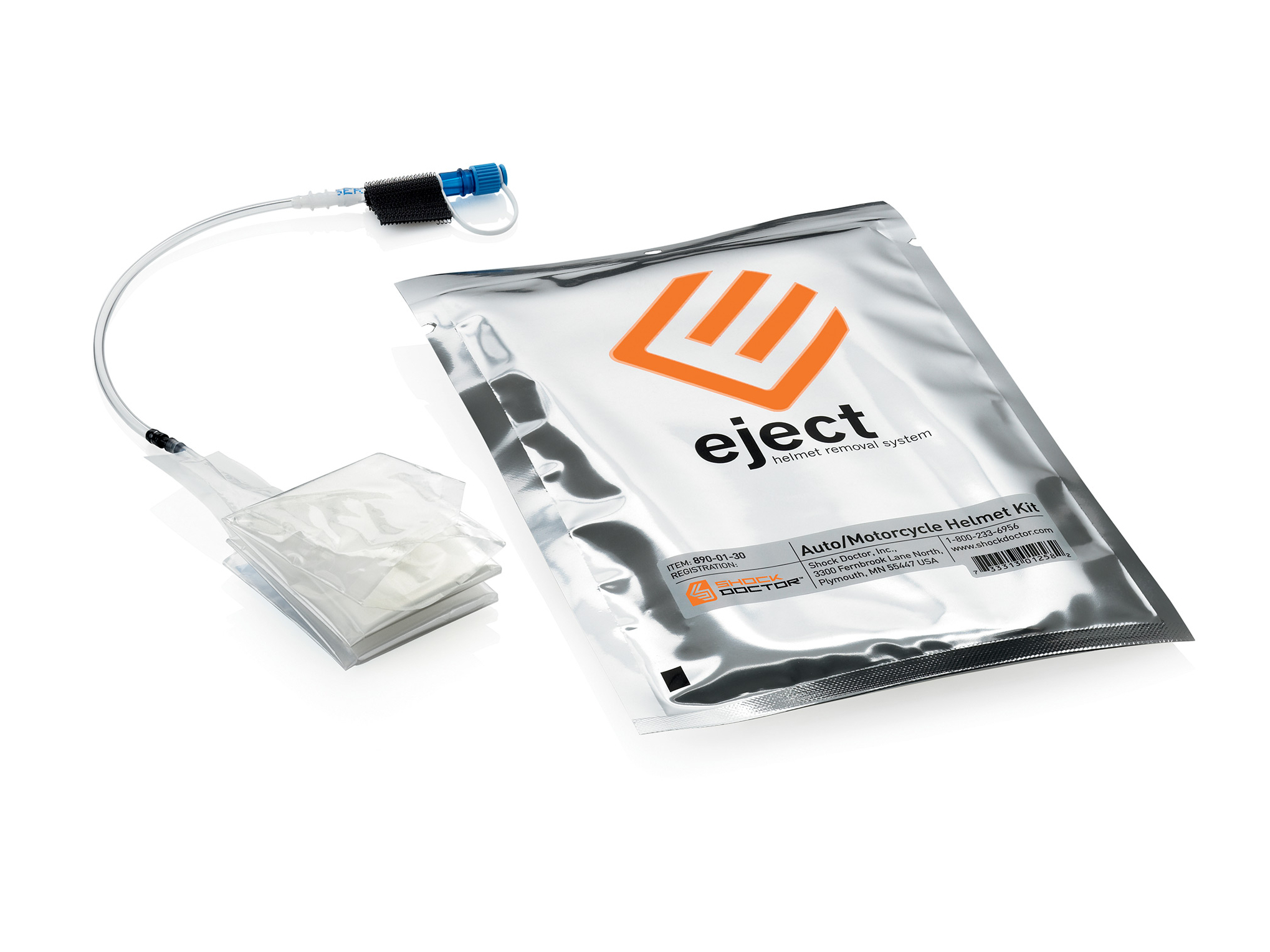Pulling the helmet off a crash victim can, in seconds, cause further trauma to the neck and cervical spine resulting in serious debilitating, and permanent damage. The Eject Helmet Removal System was designed to aid in the safer removal of a helmet by pushing the helmet off the head after the upper spine has been immobilized.
Essentially, the Eject system is an airbag that is inflated either by hand or by a CO2 cartridge when an EMT gets to you after an impact. The device is installed in your helmet. Once installed you essentially forget about it until the dark day when you have an impact that threatens your spinal cord. The EMT will attach his/her inflator bulb or CO2 cartridge to the valve hanging out of the back of your helmet and pump up the bag, lifting the helmet off your head without any strain on your neck. Because it lifts off the top of your head, the chance of further injury is drastically reduced.
-
History:
Invented in 1985 by John Deagan who, following a motorcycle accident, was left with long-term spinal injuries associated with the removal of his helmet. Originally called Hats Off and then renamed Eject, Shock Doctor acquired the patents to John’s invention in an effort to commercialize and bring his vision for safer helmet removal to a broader market. It’s lightweight, compact design is now track-proven by professional racers and EMTs across the world of motorsport.
Description:
The only removal device of its kind that provides medical caregivers at the track, or on the road, the ability to remove closed-face helmets quickly and safety without applying potentially damaging pressure or traction to the spine.
Product Specifications:
Eject is a small air bladder that fits easily into any motorcycle/auto helmet, without changing its fit or feel. Eject products include a consumer, in-helmet version and a specially designed First Responder Unit, specifically for the EMS professional.
How it Works:
Using a CO2 inflator, a small air bladder with an attached hose is inflated to quickly push the helmet off, while emergency medical personnel safely support the patient’s neck.
Ideally, if a rider’s helmet is already equipped with Eject, EMS can immediately begin medical attention. In the event that Eject is not installed, EMS is provided with an additional option for proper removal of the helmet with the First Responder Unit. Both the CO2 and handheld inflators help to remove a helmet in a matter of seconds. The Eject CO2 inflator is for EMT use only. The Eject bulb inflator is also available for purchase. Although the bulb is a slower method of inflation than the CO2 inflator, it is best to keep a bulb on-hand for backup.
-
Features
History:
Invented in 1985 by John Deagan who, following a motorcycle accident, was left with long-term spinal injuries associated with the removal of his helmet. Originally called Hats Off and then renamed Eject, Shock Doctor acquired the patents to John’s invention in an effort to commercialize and bring his vision for safer helmet removal to a broader market. It’s lightweight, compact design is now track-proven by professional racers and EMTs across the world of motorsport.
Description:
The only removal device of its kind that provides medical caregivers at the track, or on the road, the ability to remove closed-face helmets quickly and safety without applying potentially damaging pressure or traction to the spine.
Product Specifications:
Eject is a small air bladder that fits easily into any motorcycle/auto helmet, without changing its fit or feel. Eject products include a consumer, in-helmet version and a specially designed First Responder Unit, specifically for the EMS professional.
How it Works:
Using a CO2 inflator, a small air bladder with an attached hose is inflated to quickly push the helmet off, while emergency medical personnel safely support the patient’s neck.
Ideally, if a rider’s helmet is already equipped with Eject, EMS can immediately begin medical attention. In the event that Eject is not installed, EMS is provided with an additional option for proper removal of the helmet with the First Responder Unit. Both the CO2 and handheld inflators help to remove a helmet in a matter of seconds. The Eject CO2 inflator is for EMT use only. The Eject bulb inflator is also available for purchase. Although the bulb is a slower method of inflation than the CO2 inflator, it is best to keep a bulb on-hand for backup.
| Part Number | Kit Description | Price | Purchase |
|---|
